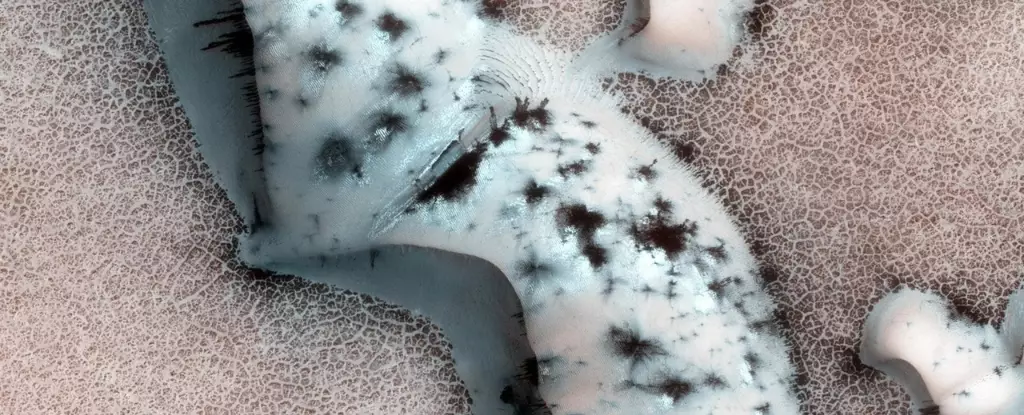Mars has long captured the imagination of scientists and space enthusiasts alike, often seen as Earth’s rusty twin. Despite its harsh environmental conditions, this enigmatic planet displays a unique beauty that stands in stark contrast to our own world. With its thin atmosphere primarily composed of carbon dioxide and an unforgiving landscape, Mars hosts phenomena that are not only fascinating but also reveal the complexities of planetary systems. In particular, the seasonal CO2 geysers of Mars provide insights into the dynamic processes that occur on its surface, highlighting a side of the Red Planet that is both beautiful and scientifically intriguing.
Most of Mars’ atmosphere consists of carbon dioxide (CO2), which significantly influences its climate and geological features. During the long winter months, CO2 freezes at the poles, forming a thick frost that blankets the Martian surface. This frost remains dormant until the arrival of spring when temperatures begin to rise. As sunlight penetrates the translucent layer of frozen CO2, it warms the ground underneath, triggering a fascinating sequence of events. The sublimation of CO2—a process where a solid transforms directly into a gas—occurs, accumulating pressure beneath the ice.
Such a dynamic atmosphere results in impressive geological features, revealing the delicate balance of temperature and pressure on the Martian surface. The subsequent eruptions of gas lead to dramatic geyser-like displays that can blanket vast areas with dark, rich material, showcasing Mars’ geological complexity. The dark spots, which can expand up to a kilometer across, speak volumes about the planet’s active processes and provide hints about the conditions beneath the surface.
The CO2 geysers on Mars are not merely stunning visual phenomena; they symbolize the planet’s geological activity. Captured by NASA’s HiRISE camera aboard the Mars Reconnaissance Orbiter, these geysers erupt with incredible force, sending jets of gas and sand-sized particles rushing at speeds nearing 160 km/h. Such eruptions create distinctive patterns on the surface, often resembling delicate spider-like features known as araneiform terrain. These formations have intrigued scientists, who describe them as “strange, beautiful geologic features” that provide further evidence of Mars’ unique environmental processes.
Understanding the mechanisms behind these geysers has led to fascinating research, including lab simulations that replicate the formation of Martian terrain. Researchers like Dr. Lauren McKeown have highlighted the beauty intrinsic to these formations, noting that they contribute to the breathtaking allure of an otherwise barren landscape. The Keiffer model, which theorizes that frost layers can become unstable under high pressure, provides a framework for understanding how these eruptions occur, explaining the gas lifecycle and its impact on the Martian surface.
Human perspective often lends itself to a deep appreciation of Earth’s natural wonders, leading to a degree of bias surrounding our understanding of beauty in nature. Generations of artists and poets have celebrated Earth’s landscapes, ecosystems, and climate with a reverence that often borders on the spiritual. However, Mars represents a different kind of beauty—one that is raw and shaped by a set of geological forces unlike any seen on Earth. The eruptions of CO2 geysers and the intricate patterns they create offer a stark reminder that beauty exists in varied forms across the solar system.
The features observed on Mars serve as critical points of study, revealing processes that showcase the planet’s dynamic nature. Unlike anything that occurs on our planet, these Martian geysers prompt us to reconsider our definitions of beauty and worth in planetary exploration. The novel phenomena found on Mars not only expand our scientific knowledge but also deepen our appreciation for the universe’s vast diversity.
While Earth may feel like the center of our emotional and spiritual connections, the breathtaking features of Mars remind us that beauty takes many forms. The CO2 geysers of Mars illustrate a mode of existence shaped by extreme conditions, revealing processes that redirect our understanding of planetary evolution. As we continue to explore Mars and uncover its hidden treasures, it becomes ever more apparent that this seemingly inhospitable planet holds its own unique allure—one that is both captivating and rich with scientific potential. Through the lens of exploration, we celebrate not just the beauty of Earth but also the intricate, chilling elegance of our closest planetary neighbor.

